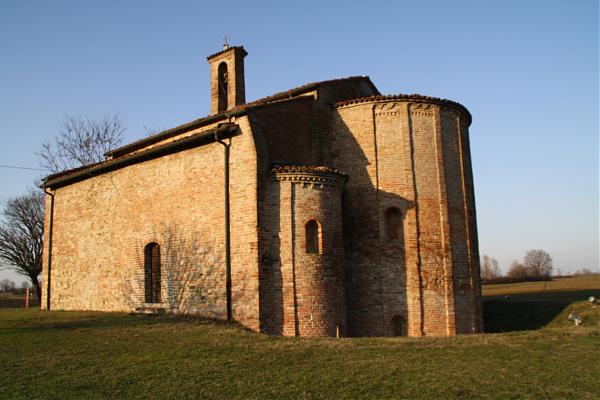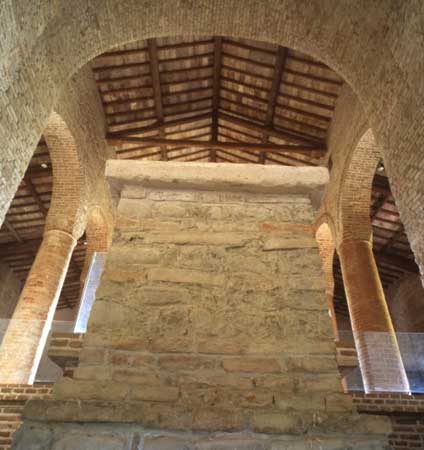


The first news of the existence of the church dates back to 1016 when the church underwent major repairs. The fact that it underwent important restorations therefore suggests that the church had already existed for a long time in fact, although there are no official documents to prove it, it seems that the parish already existed in the 9th century, probably founded by the canons of the Chapter of the Parma Cathedral at interior of the court of Pariola.

The church, dedicated to San Genesio is then explicitly mentioned in a document dated 11 February 1084 and subsequently in documents of 1179 and 1188. However, to find the title of parish one must wait until 1195 when in a document dated 31 October a certainly Giovanni di San Secondo is invested with lands owned by the chapter of the cathedral "cui sunt fines a mane plebis S.Genesii".
Equipped also with some civil functions, eleven chapels referred to in the Capitulum Decimarum of 1230 belonged to the parish: the churches of Castell'Aicardi, Corticelli, Carzeto, Santa Maria and San Bartolomeo in Casabarbato, Pariola (locality that stood on the site of the terramara del Castellazzo di Fontanellato), two churches in Tolarolo (a locality that stood between Roccabianca and Stagno), that of Fossa, of Polesine and of Corticella de ultra Pado, which was located in the territory of the current Torricella del Pizzo.

The territory also included the chapels of Pizzo, Quarta and San Secondo which, however, were directly dependent on the canons of the cathedral and four others that were headed by monastic institutions such as those of Arzenoldo and Fontanellato.
In the 13th century the parish church was rebuilt on the previous building following a flood of the Taro which probably raised the plain of the countryside and in a document dated 1299 it is clear that the borders of the parish church had remained unchanged.
However, after being one of the most important parish churches of the thirteenth century, its influence gradually waned with the urban development of the town of San Secondo which distanced it from the political and religious center. In 1450 with the construction of the Collegiate Church of the Beata Vergine Annunciata at the behest of Pier Maria II de 'Rossi, the importance of the parish declined, finally losing the seat of the parish in August 1470.
Located in the open countryside 2 km from the inhabited center, the parish began a slow agony, in 1670 the church was repaired, in 1787 the building suffered an amputation of three spans, walls were erected between the remaining intercolumns, the pitch was lowered of the roof and a new facade was built, the central nave was reduced to a simple oratory dedicated to the Madonna di Caravaggio and where there were the aisles a farmhouse and a warehouse were created.
In 1844 the Bishop of Parma Mons. Giovanni Neuchel, taking note of the unseemly state in which the church was, prohibited the celebrations on the altar until the sacred stone had been renewed. The oratory remained deconsecrated for a decade until the provost Mons. Giuseppe Cavalli promoted major restoration works.
However, the Pieve remained in a state of total abandonment until a part of the roof collapsed in September 1962, suggesting the imminent collapse of the entire structure damaged in several parts.
It was therefore decided to intervene in a radical way: between 1967 and 1972, under the direction of the Superintendency of Emilia, work was first carried out to consolidate the structure to prevent the collapse, while at the same time deciding to intervene to restore the parish to its original appearance: all the openings created in the external walls were closed, the infill walls along the columns were eliminated, restoring the building, albeit shortened, to its original configuration with three naves, and finally the roof was brought back to its original height.
During the restoration of the church, an excavation campaign was carried out in the apse area which brought to light the crypt and other structures of the church submerged by mud during the flood of the thirteenth century, these structures remained visible protected by grates and balustrades.
Excavations were also conducted outside behind the central apse bringing to light some medieval tombs.
Once the work was completed, the parish was able to return to its original function and finally be rededicated.
Parish church of San Genesio
Address: SP per Busseto, 43017
Phone:
Site:
Location inserted by
Lux Ferrari